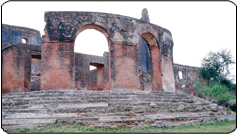Musa Bagh
The fifth Nawab of Awadh, SaadatAli Khan (1798-1814) following the pattern of the French General, Claude Martin, in his buildings on the banks of the river Gomti, on the eastern side of the city viz. Constantia (now the La Martiniere College for Boys) and Farhat Bakhsh, his town house (later known as Chhatar Manzil), also built an Indo-European style building on the river-bank at Musa Bagh, at the west end of the city. This building not only had many features similar to the Frenchman's buildings, it also had large beautiful gardens which were highly appreciated by European visitors of early 19th century.
Musa Bagh was developed as a scenic spot on a sloping ground, close to the serpentine curving riverside. The gardens presented a spectacular view of the existing grand buildings of the time at Lucknow, such as Aalamgir mosque, Machchhi Bhawan, fort, Panch Mahala, Rumi Darwaza, Asafi mosque, Bara Imambara, Sunehra Burj, Daulat Khana, and the Pucca Pul (Stone Bridge).
Musa Bagh Kothi was built under the supervision of Aazam-ud-Daulah for Nawab Saadat Ali Khan, around 1803-1804, to serve as country retreat. It was here that fights between animals like tigers, elephants, wild buffaloes and rhinos were arranged for the pleasure of the Nawab and amusement of his royal guests, quite often Europeans.
Musa is Moses in English and it is not clear how the gardens got the name of this prophet. There appears to be no notable person of this name who could be related with it in anyway. A British writer presumes it to be a corruption of Monsieur's garden - meaning the Frenchman's garden, but that appears to be far-fetched, considering the poor knowledge of French amongst Nawabs.
There is another name for Musa Bagh which is Baroween and has been used by Europeans, but in this case also, the origin of the name is not clear. Maybe it was the distortion of Urdu 'Bairoon-e Shehr' (beyond the city), an indication of the location of the Kothi and the gardens, being on the outskirts of the city, far away from the main area. The situation has not changed even today, though there appears to be a plan by the urban development authorities to disturb the serene beauty of Musa Bagh by developing a huge colony, very close to the protected archaeological site.
Musa Bagh is another five kilometres away, off the main Hardoi road, on the western end of the old city [where now the new Sabzi Mandi is located].
The structure of the Kothi of Musa Bagh is in ruins today, but two large kiosks with domed roof, a roofless structure sunk underground alongwith fluted double columns and arches in parts and other architectural features are good enough to provide a picture of the Kothi in its hey days. In fact there are two drawings, one made by Smith in 1814 and one done by D.S.Dodgson in 1858 that depict the building and the gardens of Musa Bagh in its grandeur. The building had four storeys in one portion with two storeys in another portion down on a lower level and sunk towards the riverside. It had a semi-circular portico opening to the river.
As in the Constantia and Farhat Bakhsh, the building at Musa Bagh was also provided with pottery ducts that were connected to vents on top of the flat roof. These were meant to provide cooling and ventilation. The moist earth of the riverside provided additional cooling to the sunken two storeyed portion of Baroween, and was pleasantly cool during the hot days of summer.
The excellent craftsmanship is something that cannot be ignored at Musa Bagh. The exquisite work of craftsmen and artisans of the Nawabi period may be seen to its advantage in stucco, specially in the beautiful foliage patterns on the kiosks, their domes and friezes. The art work and decoration on columns is retained in other parts of the ruins (sometimes with their original red dye intact), in the shafts and cornices.
Musa Bagh was twice offered to the British, as one of the alternative sites in lieu of Residency, once by the first King Ghazi-ud-Din Haider and later by his son Nsaeer-ud-Din Haider, but the royal guests (the British) refused to oblige and please their hosts on both occasions and held their host's accommodation, not untill they dispossessed the ruler of his property by an illegitimate annexation and became its owner in February 1856.
Musa Bagh has great historical importance in the fact that it was the last stronghold of Begum Hazrat Mahal and Prince Birjis Qadr in their struggle against the British in Lucknow, the capital of Awadh. They held the place with Maulvi Ahmad-ullah, the leader of the rebels from Faizabad on March 18, 1858, when it was attacked by Colonel James Outram, after the sacking of Qaiser Bagh. Nearly four to five hundred of the freedom fighters led by Mammu Khan were killed and all their twelve canons were captured.
Begum Hazrat Mahal, along with the Prince left for Bithauli on way to Nepal. The Maulvi went towards Payawan where he was taken prisoner [by deceit at the gate of the fort] by the brother of the Raja on June 15,1858. He was beheaded and his head was presented to the British at Shahjahanpur, who displayed it on the Kotwali gate. His body was later burnt and the ashes were thrown into the river.
In the struggle of Musa Bagh, a British officer, Captain Wales was fatally wounded and died on March 21, 1858. An enclosure in front of the ruins marks his grave at Baroween.
Source:
Hindustan Times, City Scan, A Time in History
Wednesday 11.2.1998 — Imitation's the best form of flattery

